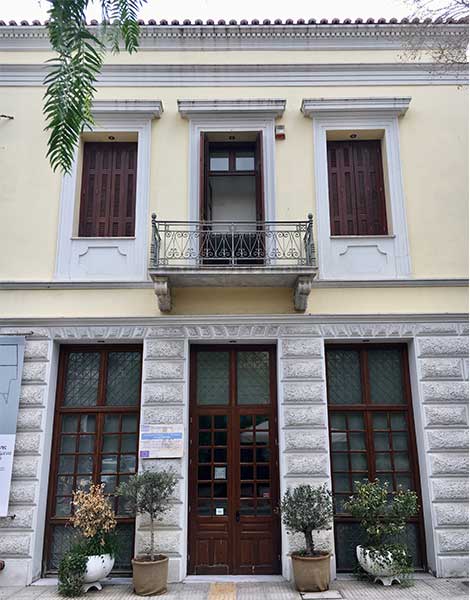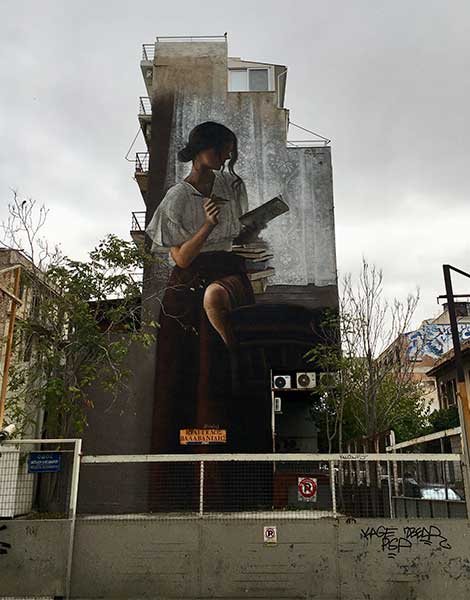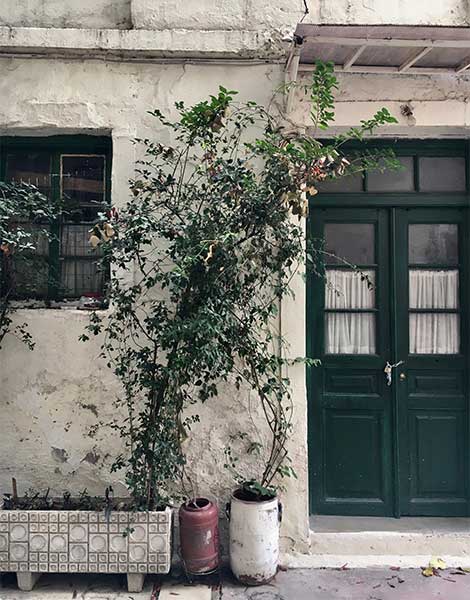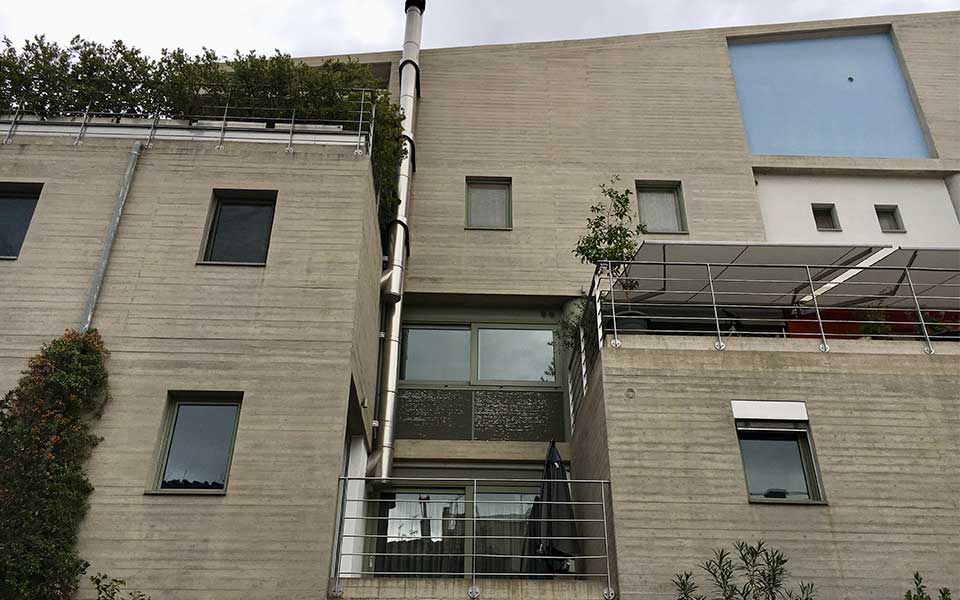Metaxourgeio is a neighborhood with clear geographical boundaries. It extends north up to Konstantinoupoleos Street, south down to Pireos Street, east to Kolokynthous Street and west to Thermopylon Street.
But my own Metaxourgeio is more like Italo Calvino’s Invisible Cities – if not entirely imaginary, certainly made exclusively of what my eyes and memory selectively hold, with limits that I choose to give it and have undoubtedly idealized. The proposed walk below (about 1.5 km) is only indicative; it’s definitely worth leaving everything to chance, taking a detour and discovering one’s own neighborhood within the neighborhood.
I start my walk from the corner of Megalou Alexandrou and Kolonou streets, where my gaze lifts upwards, to take in the street artist SimpleG’s impressive mural that covers the entire side wall of an apartment building and depicts a girl reading.
The neighborhood is home to many examples of street art that are constantly being renewed, but at the moment, this mural is, in my opinion, the most beautiful. I walk down Iasonos Street, where the few remaining brothels in the area coexist with The Breeder gallery and a series of ravaged neoclassical houses (now inhabited by stray cats). The morning traffic here always surprises me with its clamor, and even more so when the city is in the midst of a lockdown that has muted much of its ebb and flow elsewhere.

© Maria Coveou

© Maria Coveou
From Iasonos Street, I turn right onto Leonidou Street in order to reach the heart of the neighborhood, Avdi Square. Under normal circumstances, it would be full of life, and the turquoise wrought-iron seats of the Blue Parrot café would all be full. Today, even the square itself seems closed – empty except for two or three playful cats and a flock of pigeons that suddenly take off and swoop over me, Hitchcock style.
At the corner of Leonidou and Myllerou streets is Athens Municipal Gallery, also temporarily closed, housed in the neoclassical building of the old silk factory (the name Metaxourgeio literally means “silk factory”). The modern complex of flats that has been built opposite, at the corner of Myllerou and Germanikou streets, although seemingly out of place, comes as no surprise. In Metaxourgeio, everything coexists. Old and modern, kitsch and tasteful, Greek and foreign.
In the annex of the Stelios Philanthropic Foundation on Germanikou Street, free tsoureki (a sweet brioche-like bread) is distributed and about a dozen migrants queue outside. Right across the street, protagonists in another scenario, two dollhouse-like renovated neoclassical townhouses stand as testaments to a distant past when wealthy Greeks from abroad chose the area to build their well-appointed mansions.

© Maria Coveou

© Maria Coveou
Germanikou Street ends where it meets Thermopylon Street, the official western boundary of the neighborhood. I cross it and continue to the pedestrianized alley of Sfaktirias Street. At number 2 I always stand and admire the welcoming space that the owners have created on their part of the pavement with a coffee table, chairs and countless flower pots. It oozes love and care!
I turn right on pedestrianized Salaminos Street, which is particularly quiet today. Only a sweet old lady is walking around carrying her daily shopping. I wonder if she texted 13033, the number you have to message in order to leave the house.
I continue until Paramythias Street, also pedestrianized and particularly attractive, where there are buildings of different eras, street art, as well as restaurants, such as Proveleggios at number 11, the new venture of celebrity chef Sotiris Kontizas. I stop to photograph an old green door directly opposite it and then I walk and turn right on Pileos Street and immediately left on Mentoros Street where, two more exquisite and well-renovated neoclassical buildings are revealed, as surprise gifts for the passerby. I always wonder who are the lucky ones who live there.
Mentoros Street leads back onto Thermopylon Street, but I take a detour to return to Salaminos Street and walk the two blocks down to Leonidou Street.
I finish my walk next to the excavation of the Demosion Sema, the most important cemetery of ancient Athens, where in the 5th century BC prominent citizens as well as the fallen from ancient Athens’ numerous wars were buried.

© Maria Coveou
Metro artwork
The works that adorn the Metaxourgeio metro station are entitled “The myth of my neighborhood” and were commissioned in 2001 from the renowned artist Alekos Fassianos, who was born here.
On the two large paintings located at the ticketing level, the artist captured his memories of Metaxourgeio in the 1950s. On the right, the outdoor cinema Alkazar, a passing cyclist, a folk singer, and on the left a fruit market with the grocer weighing vegetables on a scale and postwar Athens barely distinguishable through the open door.
If you get hungry, there are several bakeries in the neighborhood, although I suggest you keep your appetite for some of the famous meat skewers at Elvis (Plateon 29 and Leonidou) that remains open for take away.

© Maria Coveou
The silk factory that gave the area its name
The areas of Metaxourgeio and Kerameikos may have gone through long periods of decline and abandonment, but this was once the area where the palaces of King Otto and the administrative center of the then newly created Greek state were slated to be built.
Among the many wealthy Greeks from abroad who rushed to buy land here was Prince Georgios Kantakouzinos, an heir to the well-known Byzantine Fanariot Cantacuzino family from Wallachia (present-day Romania), who in 1833 bought an expanse of land which is bordered today by Kolokynthous, Megalou Alexandrou, Thermopylon and Leonidou streets. His dream was to build his private residence here, as well as a large corner complex with shops and residences for traders.
The design and the supervision of the project were undertaken by the Danish architect Christian Hansen (who a few decades later would design the University of Athens, one of the three buildings comprising the Athenian Trilogy on Panepistimiou Street). He completed the residence (which has not survived), but left the shopping center unfinished because he had an argument with Kantakouzinos about how the work should be done.
Meanwhile, in the end the royal palace was built overlooking Syntagma (it now houses Parliament), so in 1852 Kantakouzinos sold the unfinished corner building to the English company Augustus Wrampe & Co, who would turn it into a silk mill. A year later, and even before the construction work had been finished and the various machines installed, the company declared bankruptcy, so the building went up for auction.
Only after many twists and turns (for a while it was converted into a hospital for cholera patients) did it operate as a silk factory – initially by the Greek company Athanasios G. Douroutis and Co (from 1855 to 1865), and then by Athanasios Douroutis and his brother until 1875, when it finally closed down. The factory that gave the neighborhood its name generally retains its original form and today houses the Municipal Gallery.
Source: The Metaxourgeio of Athens, Centre for Modern Greek Research of the Hellenic National Research Foundation, Athens 1995.
This article was first published in Greek on kathimerini.gr











